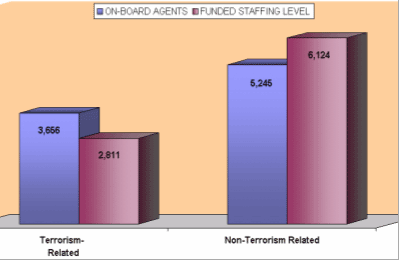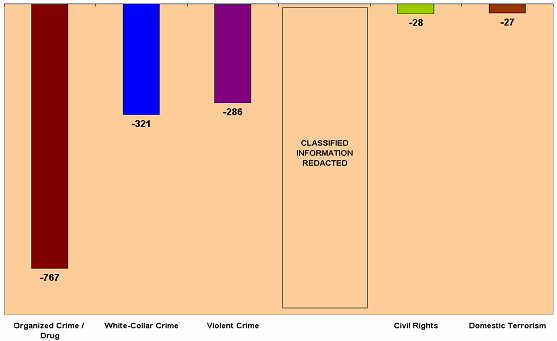In direct response to the 9/11 terrorist attacks, the FBI Director initiated a transformation of the FBI that, among other things, established a new set of priorities and formally shifted a significant number of agents from traditional criminal investigative work to counterterrorism and counterintelligence matters. According to the Director, each of the changes was designed to reshape the FBI into an organization better able to combat terrorism and to prevent another large-scale terrorist attack against the United States.
Many of the FBI officials we interviewed remarked that the FBI had shifted its attention from traditional criminal areas (e.g., drugs and violent crime) to terrorism-related matters. Specifically, they indicated three investigative areas that were negatively impacted as a result of the reprioritization: drugs, violent crime, and white-collar crime. In determining from which areas to shift resources, one of the factors FBI management considered was whether the FBI exclusively worked on particular investigative matters. For example, other agencies are involved in the investigation of illegal drug trafficking, particularly the DEA.
The results of our analyses of the allocation and utilization of agents coincide with these officials' comments. In particular, between FYs 2000 and 2003, the FBI increased its agent utilization within the National Foreign Intelligence Program (NFIP) by about 1,400 agents. Conversely, agent utilization in the Organized Crime/Drugs (OC/D), White-Collar Crime (WCC), and Violent Crime/Major Offenders (VCMO) programs combined was reduced by 1,871 agents. This indicates that the FBI significantly shifted its agent utilization from traditional criminal investigations to matters related to terrorism.
The changes in actual agent utilization were consistent with the changes in the FBI's Funded Staffing Levels (FSLs), or human resource allocation. The FBI allocated a larger number of agent resources to terrorism-related matters in FY 2003 than in FY 2000, while reducing the number of positions allotted for organized crime/drugs, violent crime, and white-collar crime during the same time period. Specifically, more than 560 additional field agent positions were allocated to terrorism-related areas in FY 2003 compared to FY 2000. In turn, the FBI reduced its funded agent resources in the noted traditional crime areas by 1,035. The majority of this reduction occurred within the Organized Crime/Drugs Program, which lost a total of 758 positions during our review period. Thus, the FBI reprogrammed resources to target its top priorities (e.g., counterintelligence and counterterrorism) by transferring resources from its traditional crime programs (e.g., drugs and violent crime).
EXHIBIT 5-1
COMPARISON OF ALLOCATED TO UTILIZED AGENTS
FISCAL YEAR 2003

Source: OIG analysis of FBI TURK and RMA Office data
As evidenced by FY 2003 data, the FBI's shift in agent resource utilization exceeded the number of positions it intended to transfer from traditional criminal investigative matters to terrorism-related areas. The FBI used 845 more agents than it had allocated for terrorism matters, while it utilized 879 fewer agents than planned in traditional crime areas. Concomitantly, in our review of casework, we found that by FY 2003 the FBI opened fewer cases in traditional criminal areas and more in areas related to terrorism. Specifically, the FBI opened 70 percent more NFIP cases and over 50 percent more DT cases in FY 2003 than in FY 2000. For the same period, the FBI opened more than 50 percent fewer organized crime/drug cases, 40 percent fewer violent crime cases, and more than 25 percent fewer white collar crime cases. In terms of terrorism and non terrorism related matters, the FBI opened 25,431 terrorism related cases in FY 2003 compared to 15,799 in FY 2000, an increase of 61 percent. Conversely, during the same timeframe the number of non terrorism related cases the FBI opened decreased from 64,281 to 40,603, reflecting a reduction of 37 percent.
In addition to evaluating resource utilization and allocation changes, we performed analyses at the FBI's investigative classification level. Of the 30 classifications experiencing the greatest increase in agent utilization between FYs 2000 and 2003, 24 of those classifications were associated with terrorism matters. Conversely, we identified the FBI's 30 investigative classifications with the greatest reductions in agent utilization. Of these, 12 pertained to organized crime/drug matters, such as Classification 245C (OCDETF - Mexican Organizations); 6 related to violent crime matters, including Classification 088A (Unlawful Flight to Avoid Prosecution - Crime of Violence); and 8 pertained to white-collar crime matters, such as Classification 209A (Health Care Fraud - Government Sponsored Program). Combined, the FBI used 1,374 fewer on-board agents in these investigative areas in FY 2003 than in FY 2000.
EXHIBIT 5-2
AGENT UTILIZATION CHANGES WITHIN PROGRAM AREAS
FOR THE 30 CLASSIFICATIONS EXPERIENCING
THE GREATEST REDUCTIONS IN AGENT UTILIZATION
FISCAL YEARS 2000 AND 2003

Source: OIG analysis of FBI TURK data
After analyzing how the reprioritization has affected the FBI's resource utilization in specific investigative areas, we plan to conduct further analyses to determine how the FBI's shift in priorities and operations has affected outside entities. We hope to discuss these effects with federal, state, and local officials in those geographical areas most affected by the reduction in the FBI's traditional criminal investigative efforts. By doing this, we hope to provide useful and comprehensive feedback to aid future operational policy decisions and to assist the FBI in its reprioritization decisions.
This report contains comprehensive, data-driven analyses of the changes in the FBI's use of resources as a result of its shift in priorities and allocation of staff. These types of analyses can be useful to FBI executive management and program directors for evaluating progress in meeting goals and obtaining a data-based view of the status of FBI operations.
Recommendation
We recommend that the FBI:
- Consider developing evaluation models similar to the ones presented in this report to assist in managing FBI programs.
Redacted and Unclassified